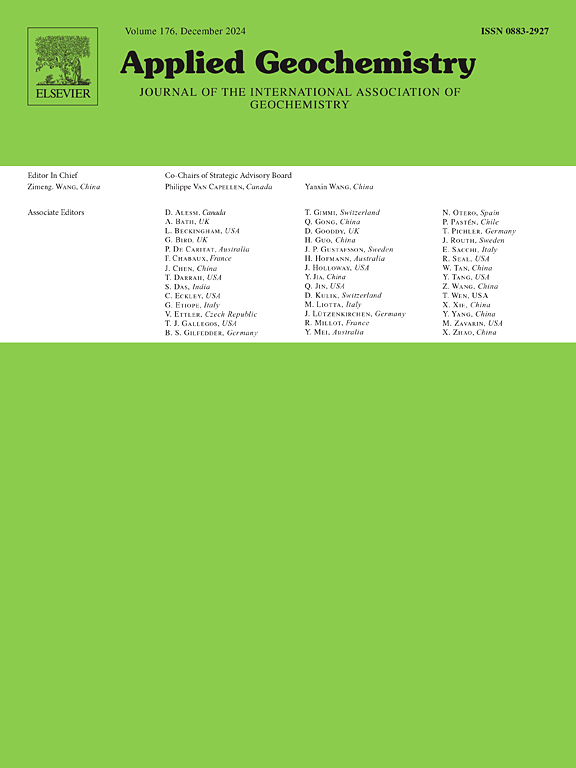利用水化学和稳定同位素描述华南某溶洞的岩溶水环境特征
IF 3.1
3区 地球科学
Q1 GEOCHEMISTRY & GEOPHYSICS
引用次数: 0
摘要
对于位于地下水季节性波动区内的洞穴遗址而言,全面了解水文地质条件和水化学环境对于评估文化沉积物的保存情况至关重要。然而,由于岩溶发育的异质性,上覆岩溶含水层的水化学环境可能呈现复杂的变化。本研究结合水文地质背景,采用水化学、氢氧同位素分析和硫酸根同位素分析等方法,对曾陂岩遗址的一个溶洞及其周围含水层的水环境特征进行了研究。根据岩溶洞穴的出露情况和地下水流动条件,含水介质被分为五种类型。含水层呈现氧化或还原状态,在溶洞饱和带观察到明显的 "溶解氧孔"。离子浓度分析表明,地下水受到上游地区先前堆积的煤渣的影响,导致山脚洞穴系统内的硫酸盐污染。然而,在地下水从上游向下游流动的过程中,污染物的衰减率出现了显著变化。值得注意的是,遗址洞穴内的硫酸盐含量异常低。通过氢和氧同位素可以了解地下水在当地环境中不同的循环和移动速度。此外,硫酸根同位素证实了硫酸根的来源,以及遗址洞穴内存在细菌硫酸根还原作用。因此,根据这些分析确定了环境分区。虽然缺氧区域的溶解离子浓度较低,但这并不意味着环境风险降低。在还原条件下,这些污染物会转化为更具侵蚀性的气体,对洞穴遗址的保护环境构成巨大威胁。因此,应充分重视这方面的问题,以确保提供足够的保护。本文章由计算机程序翻译,如有差异,请以英文原文为准。
Using hydrochemistry and stable isotopes to character the karst water environment in a cave site, South China
For cave sites located within the seasonal fluctuation zone of groundwater, obtaining a comprehensive understanding of the hydrogeological conditions and hydrochemical environment is of utmost importance in assessing the preservation of cultural deposits. However, due to the heterogeneity of karst development, the hydrochemical environment of the overburden karst water-bearing unit may exhibit complex variations. In this study, the characteristics of the water environment in a foot cave system and its surrounding aquifer were investigated at the Zengpiyan site, employing hydrochemistry, hydrogen and oxygen isotope analysis, as well as sulfate isotope analysis, in conjunction with the hydrogeological background. Based on the exposure of the karst cave and the groundwater flow conditions, the water-bearing medium was categorized into five types. The aquifer exhibited either an oxidation or reduction condition, with a distinct “dissolved oxygen hole” observed in the saturated zone of the cave site. Ion concentration analysis revealed that the groundwater was influenced by the prior accumulation of cinders in the upstream region, leading to sulfate contamination within the foot cave system. However, during the groundwater movement from upstream to downstream, the attenuation rate of pollutants displayed significant variations. Notably, the sulfate content was unusually low within the site cave. Hydrogen and oxygen isotopes provided insights into the differing circulation and movement velocities of groundwater within the local environment. Additionally, sulfate isotopes confirmed the sources of sulfate and the occurrence of bacterial sulfate reduction within the site cave. Consequently, an environmental zoning classification was established based on these analyses. Although the concentration of dissolved ions appears low in the anoxic area, it does not imply a diminished environmental risk. Under reducing conditions, these pollutants can be converted into more aggressive gases, posing a substantial threat to the preservation environment of cave sites. Therefore, sufficient attention should be given to this aspect in order to ensure adequate protection.
求助全文
通过发布文献求助,成功后即可免费获取论文全文。
去求助
来源期刊

Applied Geochemistry
地学-地球化学与地球物理
CiteScore
6.10
自引率
8.80%
发文量
272
审稿时长
65 days
期刊介绍:
Applied Geochemistry is an international journal devoted to publication of original research papers, rapid research communications and selected review papers in geochemistry and urban geochemistry which have some practical application to an aspect of human endeavour, such as the preservation of the environment, health, waste disposal and the search for resources. Papers on applications of inorganic, organic and isotope geochemistry and geochemical processes are therefore welcome provided they meet the main criterion. Spatial and temporal monitoring case studies are only of interest to our international readership if they present new ideas of broad application.
Topics covered include: (1) Environmental geochemistry (including natural and anthropogenic aspects, and protection and remediation strategies); (2) Hydrogeochemistry (surface and groundwater); (3) Medical (urban) geochemistry; (4) The search for energy resources (in particular unconventional oil and gas or emerging metal resources); (5) Energy exploitation (in particular geothermal energy and CCS); (6) Upgrading of energy and mineral resources where there is a direct geochemical application; and (7) Waste disposal, including nuclear waste disposal.
 求助内容:
求助内容: 应助结果提醒方式:
应助结果提醒方式:


